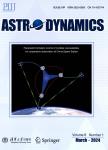Representing dynamics in the eccentric Hill system using a neural network architecture
作者机构:Department of Aerospace Engineering SciencesThe University of Colorado BoulderBoulderCO 80309USA Aduanced SpaceBoulderCo 80301USA
出 版 物:《Astrodynamics》 (航天动力学(英文))
年 卷 期:2019年第3卷第4期
页 面:301-324页
核心收录:
学科分类:0709[理学-地质学] 07[理学] 0708[理学-地球物理学] 0802[工学-机械工程] 0825[工学-航空宇航科学与技术] 0704[理学-天文学] 0701[理学-数学] 070101[理学-基础数学]
基 金:This work utilized the RMACC Summit supercomputer,which is supported by the National Science Foundation(awards ACI-1532235 and ACI-1532236) the University of Colorado Boulder,and Colorado State University
主 题:periapse Poincare map artificial neural networks eccentric Hill system
摘 要:This paper demonstrates how artificial neural networks can be used to alleviate common problems encountered when creating a large database of Poincar´e map responses.A general architecture is developed using a combination of regression and classification feedforward neural *** allows one to predict the response of the Poincar´e map,as well as to identify anomalies,such as impact or ***,this paper demonstrates how an artificial neural network can be used to predict the error between a more complex and a simpler dynamical *** an example application,the developed architecture is implemented on the Sun-Mars eccentric Hill *** statistics of the entire architecture are computed for both one Poincar´e map and for iterated *** neural networks are then applied to study the long-term impact and escape stability of trajectories in this system.



